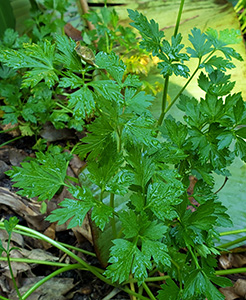Parsley
Parsley is a bright green, versatile herb that looks good growing and tastes good too.

Parsley contains vitamins A, C, and K as well as several B vitamins, calcium, and iron. It is often used as a garnish and eaten at the end of a meal to freshen your breath.
You don’t need much space to grow parsley, it even grows well in containers. One idea would be to grow it in a container with other herbs. And here’s a fun fact you may not know about this herb — it’s a host plant for caterpillars of the black swallowtail butterfly. So even if you don’t use it in the kitchen, the caterpillars will appreciate your outdoors parsley plant.
Characteristics
There are three common varieties of parsley: flat leaf, curly leaf, and parsley root. Flat leaf or Italian parsley (Petroselinum crispum neapolitanum) has leaves like celery or cilantro and is said to have the strongest flavor. Curly leaf parsley (P. crispum crispum) has very finely divided decorative leaves that make for an attractive garnish. Root parsley or ‘Hamburg’ parsley (P. crispum tuberosum) has white roots that look like young parsnips and are used similarly in cooking.
Parsley is officially a biennial, although it typically grows in Florida as a cool-season annual. Planted in the fall, parsley will thrive during winter and then flower, produce seeds, and die in late spring. You may be successful in prolonging the life of your parsley by growing it in light shade. It will bolt and flower eventually, but the good news is that bees and other pollinators love the blooms.
Planting and Care

Here in Florida, the time to plant parsley is during the cooler months of fall and winter. Parsley does best with a little afternoon shade to protect it from the intense sunlight. Potted plants are readily available or you can choose to grow it from seed. The seeds can be tricky, taking 7 to 12 days to germinate. Soaking them in water overnight before planting can improve your success. Sow the seeds shallowly and thin seedlings to 6 inches apart. Keep the soil moist for best results and be sure to carefully weed.
Most gardeners will find that only a few parsley plants are needed to fulfill their culinary wants. You can remove a few leaves at a time for continuous harvesting or harvest a whole bunch at once. Parsley leaves are most commonly used fresh, but if dried rapidly, their flavor and color can be preserved.
